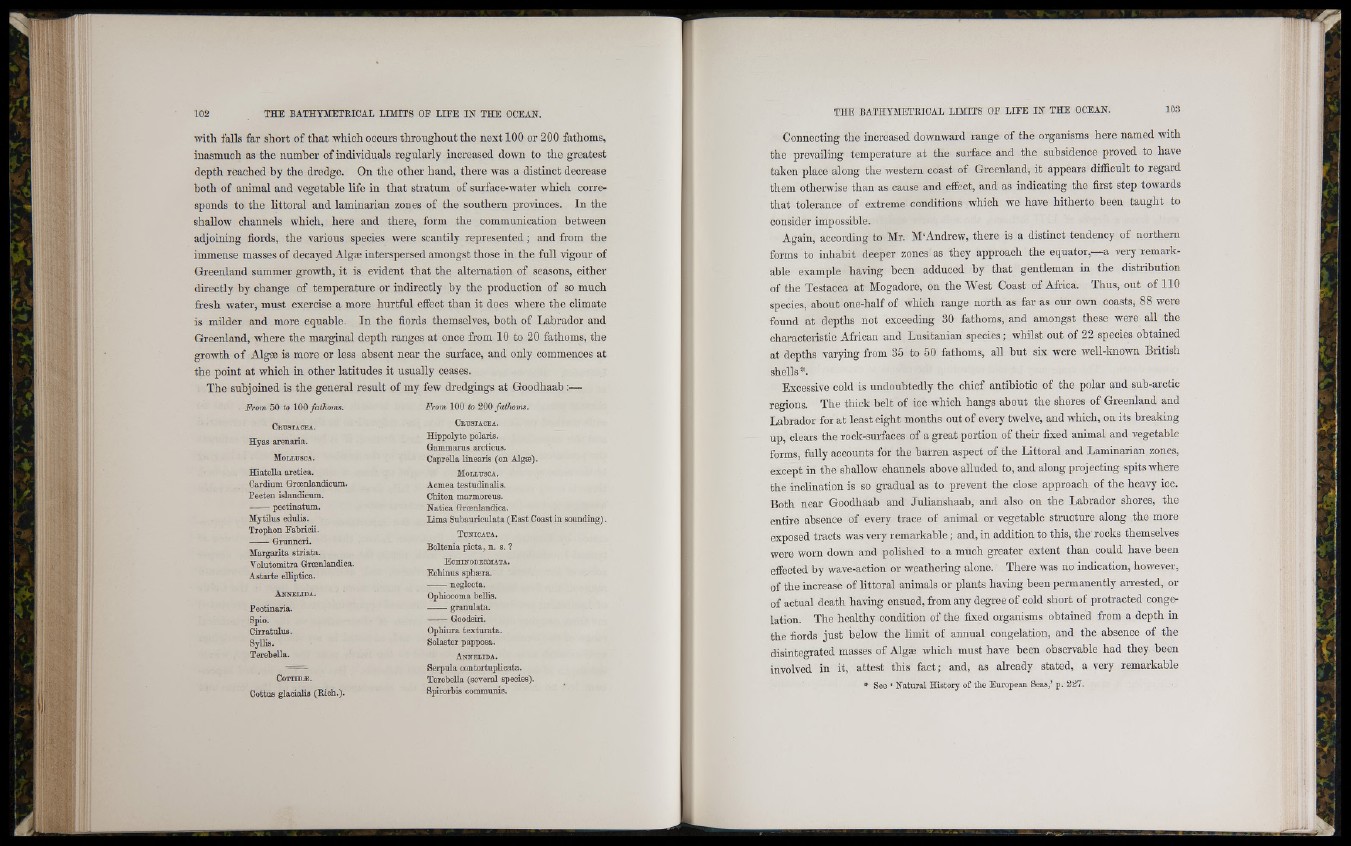
m
with falls far short of that which occurs throughout the next 100 or 200 fathoms,
inasmuch as the number of individuals regularly increased down to the greatest
depth reached by the dredge. On the other hand, there was a distinct decrease
both of animal and vegetable life iu that stratum of surface-water which corresponds
to the littoral and laminariau zones of the southern provinces. In the
shallow channels which, here and there, form the communication between
adjoining fiords, the various species were scantily represented; and from the
immense masses of decayed Alg« interspersed amongst those in the full vigour of
Greenland summer growth, it is evident that the alternation of seasons, either
directly by change of temperature or indirectly by the production of so much
fresh water, must exercise a more hurtful effect than it does where the climate
is milder and more equable. In the fiords themselves, both of Labrador and
Greenland, where the marginal depth ranges at once from 10 to 20 fathoms, the
growth o f Algse is more or less absent near the surface, and only commences at
the point at which in other latitudes it usually ceases.
The subjoined is the general result of my few dredgings at Goodhaab :—
From 50 to 100 fathoins.
Cb u s x a c e a .
Hyas arenaria.
M o l l u sc a .
Hiatella arctica.
Cardium Grcenlandicum.
Pecten islandicum.
pectinafrina.
Mytilxis edulis.
Trophon Fabricii.
Gruimeri.
Margarita striata.
Volutomitra Grcenlandica.
Astarte elliptica.
A n n e l id a .
Pectinaria.
Spio.
Cirratulus.
SyRk.
TerebeRa.
Froin 100 to 200 fathoms.
C r u s t a c e a .
Hippolyte polaris.
Gammarus arcticus.
CaprcRa Rnearis (on Algíe).
M o l l u sc a .
Acmea testudinaRs.
Chiton marmoreus.
Natica Grcenlandica.
Lima Subauriculata (East Coast in
T u n ic a t a .
Boltenia picta, n. s. ?
E c h in o d e b m a t a .
Echinus sphiera.
Ophiocoma belHs.
granulata.
Goodsiri.
Ophiura texturata.
COTTID^.
Cottus glacialis (Rich.).
A n n e l id a .
Serpula contortupRcata.
TerebeRa (seve;
Spirorbis communis.
Connecting the increased downward range of the organisms here named with
the prevailing temperature at the surface and the subsidence proved to have
taken place along the western coast of Greenland, it appears difficult to regard
them otherwise than as cause and effect, and as indicating the first step towards
that tolerance of extreme conditions which we have hitherto been taught to
consider impossible.
Again, according to Mr. M‘Andrew, there is a distinct tendency of northern
forms to inhabit deeper zones as they approach the equator,—a very remarkable
example having been adduced by that gentleman in the distribution
of the Testacea at Mogadore, on the AVest Coast of Africa. Thus, out of 110
species, about one-half of which range north as far as our own coasts, 88 were
found at depths not exceeding SO fathoms, and amongst these were all the
characteristic African and Lusitanian species; whilst out of 22 species obtained
at depths varying from 35 to 50 fathoms, all but six were well-known British
shells ®.
Excessive cold is undoubtedly the chief antibiotic of the polar and sub-arctic
regions. The thick belt of ice which hangs about the shores of Greenland and
Labrador for at least eight months out of every twelve, and which, on its breaking
up, clears the rock-surfaces of a great portion of their fixed animal and vegetable
forms, fully accounts for the barren aspect of the Littoral and Laminarían zones,
except in the shallow channels above alluded to, and along projecting spits where
the inclination is so gradual as to prevent the close approach of the heavy ice.
Both near Goodhaab and Julianshaab, and also on the Labrador shores, the
entire absence of every trace of animal or vegetable structure along the more
exposed tracts was very remarkable; and, in addition to this, the rocks themselves
were worn down and polished to a much greater extent than could have been
effected hy wave-action or weathering alone. There was no indication, however,
of the increase of littoral animals or plants having been permanently arrested, or
of actual death having ensued, from any degree of cold short of protracted congelation.
The healthy condition of the fixed organisms obtained from a depth in
the fiords just below the limit of annual congelation, and the absence of the
disintegrated masses of Algse which must have been observable had they been
involved in it, attest this fact; and, as already stated, a very remarkable
* See ‘ Natural History of the European Seas/ p. 227.